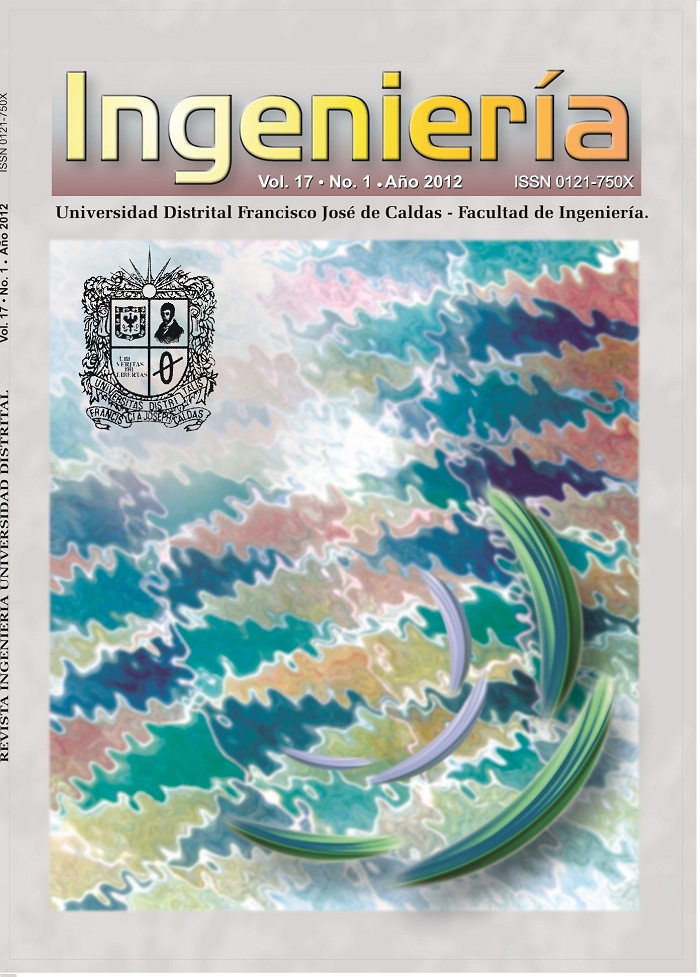DOI:
https://doi.org/10.14483/23448393.3848Published:
2012-06-29Issue:
Vol. 17 No. 1 (2012): January - JuneSection:
Special Section: Best Papers "VI Symposium on Optimization".Extracción de Líneas a partir de Escaneos Láser integrando Transformada de Hough, Mínimos Cuadrados Totales y Seguimiento de Bordes Sucesivos
Lines Extraction from Laser Scans Integrating Hough Transform, Total Least Squares and Successive Edges Following
Keywords:
straight lines, segmentation, laser data, Cartesian coordinates, Hough transform, total least squares. (en).Keywords:
Rectas, segmentación, datos láser, coordenadas cartesianas, transformada Hough, mínimos cuadrados totales. (es).Downloads
Abstract (es)
Este artículo presenta un método de segmentación de rectas, basado principalmente en un algoritmo de extracción de líneas robusto denominado transformada de Hough, para obtener los parámetros preliminares de las rectas compuestas por un conjunto de puntos suministrados por un escáner láser 2D, como los utilizados en sistemas de navegación de robots. Los parámetros de las rectas obtenidos por la transformada de Hough son ajustados por el algoritmo de Mínimos Cuadrados Totales (mejorando la precisión), y los puntos asociados a estos parámetros son nuevamente procesados por un algoritmo de Seguimiento de Bordes Sucesivos, con el fin de obtener las coordenadas cartesianas de los puntos extremos de las líneas que describen el entorno.
Abstract (en)
This paper presents a lines segmentation method, based mainly on a robust line extraction algorithm called Hough transform to obtain the preliminary parameters of straight lines composed of a set of points provided by a 2D láser scanner such as those used in robot navigation systems. The lines parameters obtained by the Hough transform algorithm are fitted by the Total Least Squares (improving the precision), and the points associated with these parameters are again processed by a Successive Edge Following algorithm in order to obtain the Cartesian coordinates of the extreme points of the lines which describe the environment.References
A. Garulli, A. Giannitrapani, A. Rossi y A. Vicino, "Mobile robot SLAM for line-based environment representation". European Control Conference 2005, pp. 2041-2046, 2005.
J. A. Castellanos y J. D. Tardós, "Laser-based segmentation and localization for a mobile robot". Robotics and Manufacturing vol. 6 - Procs. of the 6th Int. symposium(ISRAM), p. 101–108, 1996.
H. X. J. Vandorpe y H. Van Brussel, "Exact dynamic map building for a mobile robot using geometrical primitives produced by a 2d range finder". In Proceedings of the IEEE International Conference n Robotics and Automation, p. 901–908., 1996.
K. O. Arras y R. Siegwart, "Feature Extraction and Scene Interpretation for Map-Based Navigation". Symposium on Intelligent Systems and Advanced Manufacturing, 1997.
D. Kragic, P. Jensfelt, J. Folkesson y M. Bjorkman, "A framework for vision based bearing only {3D} {SLAM}". Proc. IEEE Int. Conf. on Robotics and Automation (ICRA'06), 2006.
S. T. Pfister, S. I. Roumeliotis y J. W. Burdick, "Weighted line fitting algorithms for mobile robot map building and efficient data representation". In ICRA, p. 14–19., 2003.
V. Nguyen, S. Gächter, M. Agostino, N. Tomatis y R. Siegwart, "A comparison of line extraction algorithms using 2D range data for indoor mobile robotics" Auton. Robots, vol. 23, nº 15, pp. 97-111, 2007.
J. Berrío, S. Orozco, E. Caicedo, “Lines extraction in laser scans through the integration of the Houhg transform and SEF”, 2012 Workshop on Engineering Applications, 2012.
R. O. Duda y P. E. Hart, "Use of the Hough transformation to detect lines and curves in pictures". Commun. ACM, vol. 15, nº 5, pp. 11-15, 1972.
X. Yun, K. Latt y J. Glennon, "Mobile robot localization using the Hough transform and neural networks". Intelligent Control (ISIC), 1998. Held jointly with IEEE International Symposium on Computational Intelligence in Robotics and Automation (CIRA), Intelligent Systems and Semiotics (ISAS), Proceedings, pp. 393-400, 1998.
G. H. Golub y C. Van Loan, "An Analysis of the Total Least Squares Problem", Ithaca, NY, USA: Cornell University, 1980.
J. Vandewalle y S. Van Huffel, "Analysis and solution of the nongeneric total least squares problem". SIAM J. Matrix Anal. Appl., vol. 9, nº 13, pp. 360-372, 1988.
M. Aldon, G. Borges y J., "A split-and-merge segmentation algorithm for line extraction in 2D range images". Pattern Recognition, 2000. Proceedings. 15th International Conference on, pp. 441-444, 2000.
A. Siadat, A. Kaske, S. KLAUSMANN, D. Michel y R. HUSSON, "An Optimized Segmentation Method For A 2D Laser-Scanner Applied To Mobile Robot Navigation". 3rd IFAC symposium on Intelligent Components and Instruments for Control Applications, 1997.
C. F. Caramés, "Tecnicas de navegacion de robots basados en sistemas de medicion por laser", Universidad de Salamanca, 2007.
How to Cite
APA
ACM
ACS
ABNT
Chicago
Harvard
IEEE
MLA
Turabian
Vancouver
Download Citation
License
From the edition of the V23N3 of year 2018 forward, the Creative Commons License "Attribution-Non-Commercial - No Derivative Works " is changed to the following:
Attribution - Non-Commercial - Share the same: this license allows others to distribute, remix, retouch, and create from your work in a non-commercial way, as long as they give you credit and license their new creations under the same conditions.






2.jpg)











